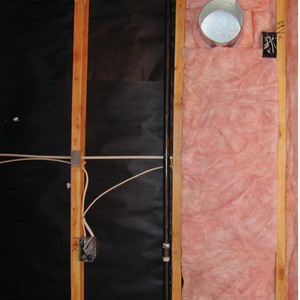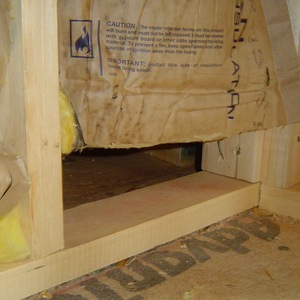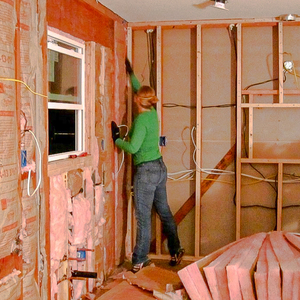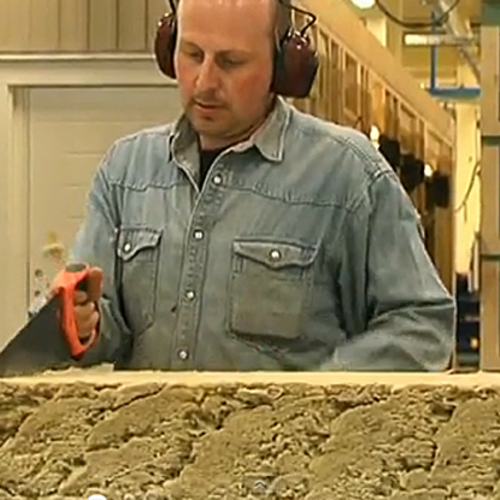
The Home Innovation Research Labs (HIRL) does an annual survey of home builders that includes what types of homes they are building and how they are building them. The results of their 2019 survey of the homes built in 2018 are out now, and they recently published an interesting article about the breakdown of different insulation materials used by home builders. Before we talk about the implications, let’s see what they found.
Here’s the pie chart showing the different insulation materials builders are installing in single-family homes. (The SF in the title below stands for “single family.”)
![Insulation materials ranked by their use by home builders [Image credit: Home Innovation Research Labs]](https://images.greenbuildingadvisor.com/app/uploads/2019/07/08183649/insulation-material-preference-home-builders-hirl-700x422.png)
Since this material makes up more than two thirds of the insulation market for new, single-family homes, this is a good time to review the problems, myths, and best practices associated with fiberglass.
Problems with fiberglass insulation
There’s really only one problem with fiberglass: poor installation. OK, it also can be really itchy if you get it on your skin and it’s a lung irritant if you’re working with it and not wearing a mask or respirator. So wear proper protective gear when you’re installing it or crawling around in a space with exposed fiberglass.
But the installation problem is well documented here and many other places. Since 2006, there’s been an insulation installation grading protocol, with grade 1 being the best and grade 3 being the worst. What I’d like to see HIRL add to their survey is how much of all that fiberglass installed each year is installed to grade 1, how much to grade 2, and how much to grade 3.
If you insulate a standard 2×4 wall with fiberglass, the average R-value drops about 12% when you install to grade 3 compared to installing it to grade 1. Yeah, when you go from R-11.8 to R-10.3, you still have a much better wall than older homes with no insulation in the walls, which would be about R-3.7. And you won’t see much of a hit from that on your monthly bills.
But those little bits add up. Grade 3 insulation installations can cost thousands of dollars in heating and cooling costs over the life of the home. And for a lot of that insulation, you get one chance to do it right before the house gets remodeled or torn down.
Myths about fiberglass insulation
I love a good myth as much as anyone, and there are some doozies out there in the world of fiberglass insulation. Here’s my number one all-time favorite:
Myth: Fiberglass-insulated homes are too leaky, resulting in high energy bills and comfort problems.
Whoa, there! Yes, fiberglass is an air-permeable insulation and many houses in which it’s been installed are definitely too leaky. But this is like blaming your stale, moldy candy bar on the ingredients rather than the fact that you bought one with a shredded wrapper.
A properly designed and installed building enclosure needs to have well thought-out control layers for heat, air, and moisture. Fiberglass is a perfectly fine control layer for heat, but it’s not going to stop air movement. That’s the job of the air barrier. You need both.
Myth: Fiberglass insulation causes cancer.
In the late 1980s, the National Toxicology Program and the state of California declared fiberglass a possible carcinogen. That was based on early studies that later were shown not to be accurate. In 2011, both removed fiberglass insulation from their lists. Read more about it in this National Insulation Association article.
Oh, by the way, fiberglass is second only to cork as a healthy insulation material. See the table in Lloyd Alter’s article on the HIRL survey to see how it ranks.
Myth: Blown fiberglass attic insulation performs poorly because of convective loops.
I’d heard this one for many years before I finally wrote about it. Yes, there was a study from the early 1990s that showed blown fiberglass in attics could lose 50% of its R-value when the attic temperature dropped. The problem was the way the insulation was made, and the fiberglass industry fixed the problem. See this article for more details.
Myth: Compression in fiberglass insulation is a bad thing.
This is another persistent one, and I have to admit that I fell for it for a while, too. The truth is that compressed insulation does have a lower R-value than that same insulation expanded to its full thickness. Here’s what I wrote in my article on this topic in 2017:
Compression isn’t the problem. Incompletely filled cavities are a problem. Gaps are a problem. But you can compress fiberglass insulation as much as you want. The North American Insulation Manufacturers Association (NAIMA) has a little two-page document about compressing fiberglass insulation. Here’s what they say:
“When you compress fiberglass batt insulation, the R-value per inch goes up, but the overall R-value goes down because you have less inches or thickness of insulation.”
If you’re filling the cavity and getting the R-value you want, compression doesn’t matter.
Best practices for fiberglass insulation
If you have any say in the design or installation of the insulation in your home, here’s a bit of guidance for you. I’m focusing on fiberglass here but the same things apply to most of the alternatives, too. I’ll break it down by what kind of assembly is being insulated, starting at the bottom.
Floors
- Don’t use fiberglass batts to insulate floors. It’s practically impossible to get a grade 1 installation with them. If the floor joists are open to below (as over a crawlspace), move the building enclosure to the walls and ground/slab by encapsulating the crawlspace or use spray foam, which won’t fall down.
- If you’re insulating a floor over a garage or over outdoor air and the cavities will be completely closed, fill the cavities with blown fiberglass.
- If there are relatively few obstructions in the cavities and the joists are dimensional lumber rather than I-joists or open-web trusses, batts can work. Again, best is to fill the whole cavity.
- Air-seal all penetrations in the floor assembly. Remember that fiberglass needs a continuous air barrier.
Walls
- Both batts and blown can work fine if you fill the cavity completely.
- With batts, cut around junction boxes and put the cut out piece behind the junction.
- Split batts around wires.
- Cut batts around pipes, blocking, and other obstructions.
- Use unfaced batts whenever possible. They’re easier to install properly as well as easier to inspect.
- Put an air barrier on the attic side of kneewalls (or eliminate kneewalls by encapsulating the attic).
Ceilings
- Blown insulation is better for filling the joist cavities.
- When installing batts, follow the guidance above for walls when it comes to fitting the batts in the cavities.
- Choose batts that are the same thickness as the depth of the joist cavities. To get more R-value, add another layer of batts, running them perpendicular to the joists, or blow insulation on top. (There’s a reason most attics have blown insulation, not batts.)
- Make sure the blown insulation reaches the minimum thickness necessary for the design R-value. Some contractors like to deliver average thickness, but that can result in significant underperformance of your insulation, as I described way back in 2010 when I wrote, Flat or Lumpy – How Would You Like Your Insulation?
The big takeaway
I’ve written many articles about insulation, a lot of them about fiberglass or applicable to fiberglass. The most important thing I want you to take away from this article today is that you need to understand fiberglass—or any insulation material, really—to get the most out of it. As I wrote above, the main problem is poor installation. Learn the truth behind the myths so you can dismiss them. And then follow the best practices I outlined above.
Fiberglass is a perfectly fine insulation material with a bad rap because of all the sins committed—or said to be committed—in its name. Learn the truth, do it right, and you’ll be healthy, wealthy, and comfortable…or at least a bit closer!
Allison Bailes of Decatur, Georgia, is a speaker, writer, building science consultant, and the author of the Energy Vanguard Blog. You can follow him on Twitter at @EnergyVanguard.
Weekly Newsletter
Get building science and energy efficiency advice, plus special offers, in your inbox.















One Comment
Attached is the link to my slide presentation on Proper Thermal Insulation and plenty of pictures that show why fiberglass doesn't perform in most field installations.
https://docs.wixstatic.com/ugd/24dbd8_3c197eb6679249be9ea98353bd5a8328.pdf
Log in or create an account to post a comment.
Sign up Log in